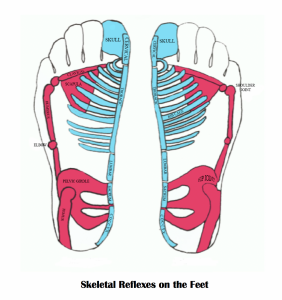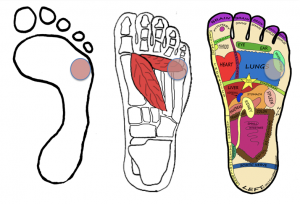If you have chronic shoulder pain you may want to check out the ball (fifth metatarsal head) beneath your little toe area for a possible answer and that would be, a callus. Calluses that appear on the foot is a sign one is developing a foot problem and the location of a callus means the associated reflex is also reacting.
When the foot is subjected to excessive friction the nervous system will respond by accelerating development of epidermal tissue at the site to protect the underlying structure. The greater the issue, the thicker the tissue.
Uniformly, callused skin on the bottom of feet is normal and actually protects barefoot walkers, however calluses that form on specific areas such as at the ball beneath the little toe means that area of the foot is taking too much weight, or in some cases, none at all. The weight of the upper body then becomes a burden to the disabled little toe that can no longer provide a stable foundation for the shoulder girdle which responds by folding inward to minimize its girth and heaviness. This shoulder posture requires chronic, muscle tension to maintain upper body balance and over time the shoulder muscles lose functional integrity and become inflamed from strain causing symptoms such as frozen shoulder, bursitis, and even brachial plexopathy.

The appearance of isolated calluses on the foot indicate a weight distribution issue. Not from weight in the sense of being over-weight, but from how well the foot can carry the weight of the body based on healthy foot alignment. However, if joints in the foot become locked or misaligned, then weight of the body becomes more apparent.
Even though feet weigh approximately two percent of the total body, these mighty appendages are perfectly designed to carry 98% of the weight above. In fact, according to the late orthopedist, Dr. John Martin Hiss
normal and healthy ligament structure of the foot can withstand the weight of 7860 pounds per square inch.
The little toe helps to stabilize and balance the side-body as muscles that move the foot direct weight from the lateral side of the foot toward the great toe during locomotion. The ability of the little toe to perform this very vital function is determined by space shoes allow. Most shoes don’t provide room for this special little digit which often gets tucked against or beneath the fourth toe.
Try as you may to smooth and buff these pesky calluses away they soon reappear and, more quickly than you might think. You see, buffing only thins the skin and makes the area beneath more vulnerable to further damage- and the brain knows better than to leave this polished area exposed.
In order to prevent callusing and developing foot and shoulder issues choose shoes that give all toes room to move. In fact, allowance should be enough to tap the tip of a pencil between each toe while the foot rests in the shoe. Once shoe-style has changed to accommodate foot size and shape callus and shoulder pain will often dissipate.
Try this fun test to see if your shoes fit the shape and size of your feet: Have someone trace each foot, cut the tracing along the pencil line, and then place the cut-out in your shoe. If it doesn’t fit easily in the shoe neither will your foot and any part of the foot that folds to fit the shoe will eventually affect another part of the body.
Visit my tennis ball exercises blog to treat yourself to self-care reflexology here:
Illustrations by Geraldine Villeneuve
Archives
- October 2024
- December 2023
- October 2023
- March 2022
- July 2021
- August 2020
- May 2020
- April 2020
- February 2020
- January 2020
- December 2019
- November 2019
- October 2019
- August 2019
- June 2019
- May 2019
- April 2019
- January 2019
- December 2018
- October 2018
- September 2018
- July 2018
- June 2018
- April 2018
- February 2018
- December 2017
- November 2017
- October 2017
- September 2017
- August 2017
- July 2017
- June 2017
- May 2017
- April 2017
- February 2017




2 Responses to Making Connection between Shoulder Pain and a Foot Callus